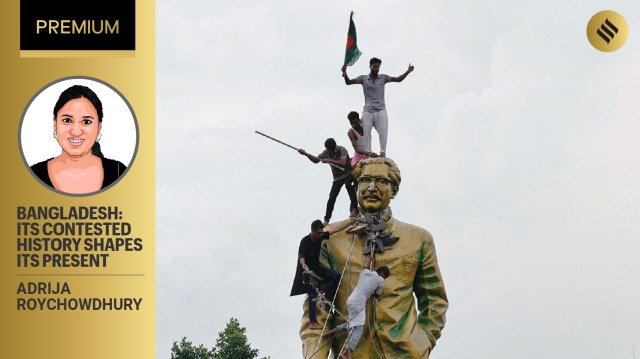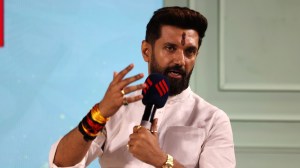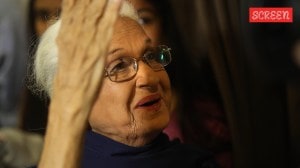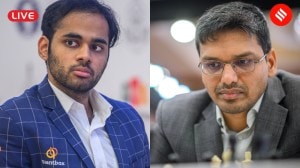The image of the public desecration of Sheikh Mujibur Rahman’s statue in Dhaka is perhaps the most telling spectacle of resistance in the ongoing political developments in Bangladesh. The attack on Mujib would appear to be a symbol of opposition to the dominant historical narrative about the Bangladesh Liberation War as we have known for decades. Scholars suggest that this reading of Bangladesh’s history is not necessarily untrue, but exaggerates certain episodes and characters while obliterating others.
The Bangladesh Liberation War of 1971 was indeed a watershed moment in the history of the subcontinent. The making of Bangladesh altered both the geography and the geopolitics in the region. Sheikh Mujibur Rahman is often seen as the ‘father’ of this new nation, representative of Bengali middle-class aspirations that fought against the domination of West Pakistan. The 1971 war, in that sense, has been central to the nation-building project in Bangladesh.
Nayanika Mookherjee, Professor of Political Anthropology at Durham University, UK, suggests that since the birth of Bangladesh in 1971, every regime change in the country has been accompanied by a re-writing of its history and a re-adjustment of the signposts of history. “In 1996, when the Awami League came to power, a predominant part of society across all classes accepted their narrative of the centrality of leadership of Sheikh Mujib for Muktijuddho (Bangladesh Liberation War) and his seventh of March clarion call for independence as the watershed moment of the liberation war,” says Mookherjee, who has authored the book The Spectral Wound: Sexual Violence, Public Memories, and the Bangladesh War of 1971 (2015).
For the Bangladesh Nationalist Party (BNP), though, it was the night of March 25, 1971, when the Pakistan Army carried out Operation Searchlight to curb Bengali nationalist sentiment that became the most important signpost of Bangladesh’s history. The BNP is the primary Opposition party in Bangladesh and was founded by General Ziaur Rahman or General Zia in 1978. In the BNP’s version of the historical narrative, General Zia is at the centre.
 General Zia with his wife Khaleda Zia in 1979 (Wikimedia Commons)
General Zia with his wife Khaleda Zia in 1979 (Wikimedia Commons)
General Zia had made the official radio announcement of the independence of Bangladesh in the early hours of March 26, 1971, and later was appointed the commander of the first conventional brigade of the Bangladesh forces, which launched major attacks on Pakistani forces. “Sheikh Mujib and General Zia fought together for the country’s liberation. In a radio broadcast from Kalurghat, Zia accepted Mujib as the country’s leader. However, the Awami League’s narration enforces that only Mujib and AL cadres fought for the country’s liberation,” explains Amit Ranjan, a research fellow on Bangladesh politics at the National University of Singapore (NUS).
“The BNP believes in a more militarised version of the liberation war while the Awami League prefers to concentrate on the civilian aspect of the war with Sheikh Mujib at the helm,” explains Mookherjee.
Recently, under the Awami League government and the Digital Security Act, any criticism of Sheikh Mujib or government policies became severely punitive, leading to imprisonments, unsuspended charges, deaths and an authoritarian control of the narrative.
Story continues below this ad
Then there is the signpost of the Partition in 1947, which is a matter of huge discomfort and is rather skipped in the official historical narrative of the country. Following the research of various Bangladeshi scholars, Mookherjee argues, “If one talks about the 1947 Partition, then they would have to acknowledge that it was the same group of people who once demanded Pakistan and that soon gave way to the demands for a Bengali state since the context of colonisation had changed.”
Political scientist Taj Hashmi provides an alternative reading of the liberation movement in his book Fifty Years of Bangladesh, 1971-2021 (2022) when he argues that in the early 1970s, Sheikh Mujib was keen on having a united Pakistan. In the early 1960s, Sheikh Mujib had attempted to seek Indian assistance in the secession of East Pakistan. However, after being refused help by the then Indian Prime Minister Jawaharlal Nehru and then later having won a majority of the seats in the 1970 election, he was desperately trying to become prime minister of a united Pakistan. Hashmi, who was a student in Dhaka in 1971, asserts that Mujib gave his March 7 speech under great duress and pressure from the student protestors. “He, in fact, ends his speech with ‘Joy Bangla, Joy Pakistan’,” says Hashmi.
Mookherjee argues that “one must keep in mind that we are reading the history of Pakistan and Bangladesh only in retrospect”. In interviews with student leaders of 1971, many emphasised to Mookherjee that students made the demand for independence with Sheikh Mujib. “In March 1971, Mujib would not have known that in a few weeks time, West Pakistan’s army would carry out a genocidal operation and everything else that was to follow. In my own research on wars and conflicts, I have found people keep their various options open as a mode of survival as they do not know what the trajectory of events would end up being,” she says.
Marginalised actors, forgotten strands of nationalism
Cultural anthropologist Dina Siddiqi argues in an email interview that the “Awami League’s version of history is selective, based on historical amnesia rather than untrue”.
Story continues below this ad
Political scientist Ali Riaz explains that the Mujib-centric narrative of the liberation war neglects the role played by several other important actors, many of whom were a part of the Awami League. For instance, he cites the example of Tajuddin Ahmad. After the arrest of Sheikh Mujib on March 25, 1971, by the West Pakistan Army, it was Ahmad who led a provisional government in the Meherpur district of western Bangladesh, bordering India. It was only on January 8, 1972, that Sheikh Mujib was released, by when Bangladesh was declared an independent country.
 Maulana Bhashani, also known as Red Maulana, was a key figure in the 1960s (Wikimedia Commons)
Maulana Bhashani, also known as Red Maulana, was a key figure in the 1960s (Wikimedia Commons)
Riaz goes on to argue that several strands of nationalism, apart from the language-based one, were active in Bangladesh during the struggle for liberation, and have been marginalised by the Awami League.
Maulana Bhashani, for instance, was a key figure in the 1960s, though he is rarely placed in the pedestal of greats in Bangladesh. Popularly known as Red Maulana, he was the first president of the Awami League. “Bhashani was a Leftist leader, but he also brought an Islamic sensibility to it,” says Riaz.
Then there were the pro-Chinese Leftists, who, explains Riaz, “believed that the struggle against West Pakistan was not only a nationalist one but also one against capitalist oppression”.
Story continues below this ad
There also existed a huge literary movement in East Bengal from the 1930s onwards that was specifically centred around the Muslim identity, which has been overlooked in the writing of Bangladesh’s history. “They were focused on ensuring that religion-based identity and language-based nationalism are merged in a way that they are not seen as opposed to one another,” explains Riaz.
Some believed in the idea of a united Pakistan. “The relation with Pakistan was not all rejection. At the time of the 1947 Partition, large segments of the population in East Bengal (Muslims and namasudras) were excited at the prospect of Pakistan because it was a chance to throw off the chains of zamindari and work toward a more equal dispensation,” says Siddiqi in an email interview.
Contested numbers, undocumented victims, and ‘war heroines’
The narrative of wartime violence is yet another aspect that continues to sit rather uncomfortably among several segments of Bangladesh society. To begin with, there is a debate over how many civilians were killed during the liberation war. An iconic figure of three million is accepted by the Awami League and a large section of civil society.
Ranjan, in a research paper published in 2016, citing David Bergman, writes that “this figure was, in fact, first stated by Sheikh Mujibur Rahman in an interview with the British broadcaster David Frost”. This number even surprised some of Mujib’s confidantes and is contradicted by many researchers and other governments, says Ranjan, adding, “Many suspected that Mujib had meant to say three lakhs.”
Story continues below this ad
The Pakistani army contends the number to be around 26,000, much below the reality. The three million figure has also been questioned by the BNP leader and widow of General Zia, Khaleda Zia in December 2015. It was soon followed by the home ministry pressing sedition charges against her for questioning the official figures.
That apart, there is also the national blind spot about the non-Bengali, Urdu- or Hindustani-speaking Muslims of East Pakistan who became a part of Bangladesh, collectively referred to as ‘Biharis’. “The Biharis were seen suspiciously because they did not share in the ‘Bangaliness’ which was to become the core of the nation,” says Professor Ananya Jahanara Kabir, who has authored the book Partition’s Post-Amnesias: 1947, 1971 and Modern South Asia (2013).
The popular narrative of the war has almost exclusively focused on the Pakistani Army’s actions against the Bengalis. Journalist and scholar Sarmila Bose in her 2005 research paper has focused upon the massacre carried out by Bengali mobs on Biharis at Khulna and Chittagong in March 1971.
Then there are the Bengali rape survivors of the war, whose experience and trauma have been woven into the nation-building process of Bangladesh. In The Spectral Wound (2015), Mookherjee writes, “Faced with a huge population of rape survivors, the Bangladesh interim government in December 1971 under Kamruzzaman (Abul Hasnat Muhammad Kamruzzaman) publicly designated any woman raped in the war a ‘birangona’ (meaning brave or courageous women; the Bangladeshi state uses the term to mean ‘war heroine’).”
Story continues below this ad
This bold and public effort to honour wartime rape victims was, as noted by Mookherjee, “internationally unprecedented”. “Between 1996-2001, the attempt to document the narratives of birangonas was predominantly marked by sensationalism and an attempt to horrify her narrative further,” she says, “as if the wartime experience of being raped was not traumatic enough”.
From 2001, however, extensive attempts have been made by many Bangladeshi feminists, writers and filmmakers to decentre the nationalist narrative related to the history of birangonas by addressing the various blind spots within it, particularly the untold accounts of the rape of non-Bengali women by liberation fighters during 1971.
Discussing why the historical narrative of Bangladesh remains fractured, Kabir says, “Bangladesh’s birth is relatively recent, in the sense that those who were part of the liberation struggle are still alive and active in public life. It is only expected that it would be difficult for them to step back and take an ‘objective’ view of history.”
“This just suggests that nation-building in Bangladesh is still far from complete,” Kabir adds.
Further Reading:
Story continues below this ad
Taj Hashmi; Fifty Years of Bangladesh, 1971-2021: Crises of Culture, Development, Governance, and Identity; Springer International Publishing; 2023
Nayanika Mookherjee; The Spectral Wound: Sexual Violence, Public Memories, and the Bangladesh War of 1971; Duke University Press; 2015
Ananya Jahanara Kabir; Partition’s Post-amnesias: 1947, 1971 and Modern South Asia; Women Unlimited; 2013
Sharmila Bose; Anatomy of Violence: Analysis of Civil War in East Pakistan in 1971; Economic and Political Weekly; 2005
Story continues below this ad
Dina Siddiqi; Left Behind By the Nation: ‘stranded Pakistanis’ in Bangladesh; A Journal of Social Anthropology and Cultural Studies; 2013
Amit Ranjan; Bangladesh Liberation War of 1971: Narratives, Impacts and the Actors; India Quarterly; 2016



 General Zia with his wife Khaleda Zia in 1979 (Wikimedia Commons)
General Zia with his wife Khaleda Zia in 1979 (Wikimedia Commons) Maulana Bhashani, also known as Red Maulana, was a key figure in the 1960s (Wikimedia Commons)
Maulana Bhashani, also known as Red Maulana, was a key figure in the 1960s (Wikimedia Commons)





























